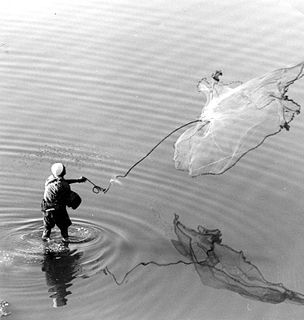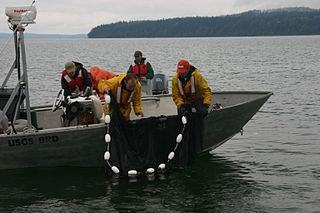 W
WA fishing net is a net used for fishing. Nets are devices made from fibers woven in a grid-like structure. Some fishing nets are also called fish traps, for example fyke nets. Fishing nets are usually meshes formed by knotting a relatively thin thread. Early nets were woven from grasses, flaxes and other fibrous plant material. Later cotton was used. Modern nets are usually made of artificial polyamides like nylon, although nets of organic polyamides such as wool or silk thread were common until recently and are still used.
 W
WA casting net, also called a throw net, is a net used for fishing. It is a circular net with small weights distributed around its edge.
 W
WChinese fishing nets are a type of stationary lift net in India. They are fishing nets that are fixed land installations for fishing. While commonly known as "Chinese fishing nets" in India, the more formal name for such nets is "shore operated lift nets". Huge mechanical contrivances hold out horizontal nets of 20 m or more across. Each structure is at least 10 m high and comprises a cantilever with an outstretched net suspended over the sea and large stones suspended from ropes as counterweights at the other end. Each installation is operated by a team of up to six fishermen. While such nets are used throughout coastal southern China and Indochina, in India they are mostly found in the Indian cities of Kochi and Kollam, where they have become a tourist attraction. This way of fishing is unusual in India and almost unique to the area, as it was introduced by Chinese explorers who landed there in the 14th century. Indeed, one interpretation of the city name Kochi is ‘co-chin', meaning ‘like China.’
 W
WDrift netting is a fishing technique where nets, called drift nets, hang vertically in the water column without being anchored to the bottom. The nets are kept vertical in the water by floats attached to a rope along the top of the net and weights attached to another rope along the bottom of the net. Drift nets generally rely on the entanglement properties of loosely affixed netting. Folds of loose netting, much like a window drapery, snag on a fish's tail and fins and wrap the fish up in loose netting as it struggles to escape. However the nets can also function as gill nets if fish are captured when their gills get stuck in the net. The size of the mesh varies depending on the fish being targeted. These nets usually target schools of pelagic fish.
 W
WGillnetting is a fishing method that uses gillnets: vertical panels of netting that hang from a line with regularly spaced floaters that hold the line on the surface of the water. The floats are sometimes called "corks" and the line with corks is generally referred to as a "cork line." The line along the bottom of the panels is generally weighted. Traditionally this line has been weighted with lead and may be referred to as "lead line." A gillnet is normally set in a straight line. Gillnets can be characterized by mesh size, as well as colour and type of filament from which they are made. Fish may be caught by gillnets in three ways:Wedged – held by the mesh around the body. Gilled – held by mesh slipping behind the opercula. Tangled – held by teeth, spines, maxillaries, or other protrusions without the body penetrating the mesh.
 W
WHaaf net fishing is an ancient type of salmon and sea trout net fishing practised in Britain, and is particularly associated with the Solway Firth, the estuary forming part of the border between England and Scotland. The technique involves fishermen standing chest-deep in the sea and using large submerged framed nets to scoop up fish that swim towards them. It is a form of fishing that is believed to have been brought to Britain by the Vikings more than a thousand years ago and to have been practised in the Solway Firth since then.
 W
WA hand net, also called a scoop net or dip net, is a net or mesh basket held open by a hoop. It may or may not be on the end of a handle. Hand nets have been used since antiquity and can be used for scooping fish near the surface of the water, such as muskellunge or northern pike.
 W
WA lampara net is a type of fishing net. It is a surrounding net having the shape of a spoon or a dustpan with a short leadline under a longer floatline. The net has a central bunt to contain the fish and two lateral wings.
 W
WA lave net is a type of fishing net used in river estuaries, particularly in the Severn Estuary in Wales and England to catch salmon.
 W
WLift nets, also called lever nets, are a method of fishing using nets that are submerged to a certain depth and then lifted out of the water vertically. The nets can be flat or shaped like a bag, a rectangle, a pyramid, or a cone. Lift nets can be hand-operated, boat-operated, or shore-operated. They typically use bait or a light-source as a fish-attractor. Lift nets are also sometimes called "dip nets", though that term applies more accurately to hand nets.
 W
WSalambáw, is a type of lift net used by indigenous fishermen in the Philippines. They are found throughout the Philippine islands but are most prevalent in large lakes like Laguna de Bay, and sheltered coastal areas like the Manila Bay, Ragay Gulf, and Batan Bay. Variations of salambáw lift nets include the bintol, panak, tangkal, and the basnig. Salambáw rafts were also known as saraboa or salakab.
 W
WSeine fishing is a method of fishing that employs a surrounding net, called a seine, that hangs vertically in the water with its bottom edge held down by weights and its top edge buoyed by floats. Seine nets can be deployed from the shore as a beach seine, or from a boat.
 W
WA surrounding net is a fishing net which surrounds fish and other aquatic animals on the sides and underneath. It is typically used by commercial fishers, and pulled along the surface of the water. There is typically a purse line at the bottom, which is closed when the net is hauled in.
 W
WSimilar to a gillnet, the tangle net, or tooth net, is a type of nylon fishing net. Left in the water for no more than two days, and allowing bycatch to be released alive, this net is considered to be less harmful that other nets. The tangle net is used in the Philippines by commercial fishermen, as well as by the scientific community. When spent, these nets can be bundled, and left on the sea floor to collect smaller species. These bundles are known locally as lumen lumen nets.
 W
WTrawling is a method of fishing that involves pulling a fishing net through the water behind one or more boats. The net used for trawling is called a trawl. This principle requires netting bags which are towed through water to catch different species of fishes or sometimes targeted species. Trawls are often called towed gear or dragged gear.